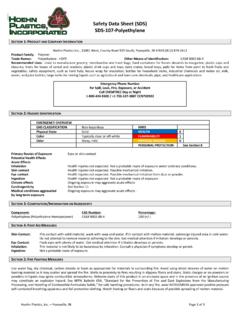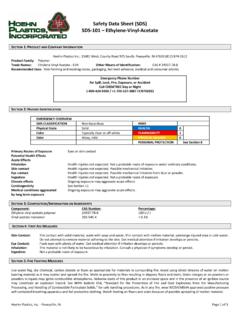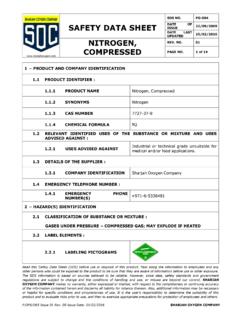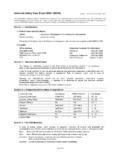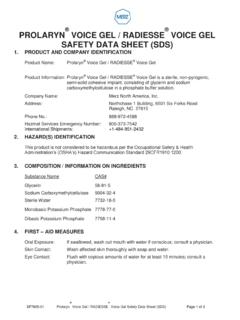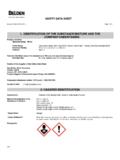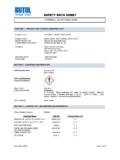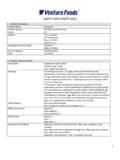Transcription of Safety Data Sheet (SDS) SDS 111 Polypropylene
1 Safety data Sheet (SDS) SDS 111 Polypropylene SECTION 1: PRODUCT AND COMPANY INFORMATION Hoehn Plastics Inc., 11481 West, County Road 925 South, Poseyville, IN 47633 (812) 874 2612 Product Family: Polymer Trade Names: Polyproplene Other Means of Identification: CAS# 9003 07 0 Recommended Uses: Used in packaging and fabric especially in laboratory equipment where resistance to many chemical solvents, bases and acids is important. Emergency Phone Number for Spill, Leak, Fire, Exposure, or Accident Call CHEMTREC Day or Night 1-800-424-9300 / +1 703-527-3887 CCN702922.
2 SECTION 2: HAZARD IDENTIFICATION EMERGENCY OVERVIEW GHS CLASSIFICATION Non hazardous HMIS Physical State Solid HEALTH 0 Color Typically clear or off white FLAMMABILTY 1 Odor Waxy, mild PHYSICAL HAZARD 0 PERSONAL PROTECTION See Section 8 Primary Routes of Exposure Eyes or skin contact Potential Health Effects Acute Effects Inhalation Health injuries not expected. Not a probable route of exposure under ordinary conditions. Skin contact Health injuries not expected. Possible mechanical irritation. Eye contact Health injuries not expected.
3 Possible mechanical irritation from dust or powder. Ingestion Health injuries not expected. Not a probable route of exposure. Chronic effects Ongoing exposure may aggravate acute effects Carcinogenicity See Section 11 Medical conditions aggravated Ongoing exposure may aggravate acute effects . by long term exposure SECTION 3: COMPOSITION/INFORMATION ON INGREDIENTS Component CAS Number Percentage Polyproplene) CAS# 9003 07 0 100 (+/ ) SECTION 4: FIRST AID MEASURES Skin Contact: If in contact with solid material, wash with soap and water.
4 If in contact with molten material, submerge injured area in cold water. Do not attempt to remove material adhering to the skin. Get medical attention if irritation develops or persists. Eye Contact: Flush eyes with plenty of water. Get medical attention if irritation develops or persists. Inhalation: This material is not likely to be hazardous by inhalation. Consult a physician if symptoms develop or persist. Ingestion: Not a probable route of exposure. SECTION 5: FIRE FIGHTING MEASURES Use water fog, dry chemical, carbon dioxide or foam as appropriate for materials in surrounding fire.
5 Avoid using direct streams of water on molten burning material as it may scatter and spread the fire. Melts in proximity to fires resulting in slippery floors and stairs. Static charges or on powders or powders in liquids may ignite combustible atmospheres. Airborne dusts of this product in an enclosed space and in the presence of an ignition source may constitute an explosion hazard. See NFPA Bulletin 654, Standard for the Prevention of Fire and Dust Explosions from the Manufacturing Processing, and Handling of Combustible Particulate Solids, for safe handling procedures.
6 As in any fire, wear NIOSH/MSHA approved positive pressure self contained breathing apparatus and full protective clothing. Watch footing on floors and stairs because of possible spreading of molten material. Hoehn Plastics, Inc. Poseyville, IN Page 1 of 3 Safety data Sheet (SDS) SDS 111 Polypropylene SECTION 6: ACCIDENTAL RELEASE MEASURES Refer to Section 8: Exposure Control and Personal Protection Emergency Action: No special environmental precautions required. Spill/Leak Procedure: Containment of this material should not be necessary.
7 Sweep up or gather material and place in appropriate container for disposal. SECTION 7: HANDLING AND STORAGE Refer to Section 8: Exposure Control and Personal Protection Handling: Keep away from heat, flame and strong oxidizing agents. Storage: Keep away from heat, sparks, and flame. Store in a cool place in original container and protect from sunlight. SECTION 8: EXPOSURE CONTROL AND PERSONAL PROTECTION Engineering Controls: Use recommended safe handling practices to minimize unnecessary exposure.
8 General room ventilation is adequate for storage and ordinary handling. Use local exhaust at points of fume generation or if dusty conditions prevail. Personal Protective Equipment: Wear Safety glasses with side shields or chemical goggles to prevent eye contact. Have eye washing facilities readily available where eye contact can occur. Do not wear contact lenses when working with this substance. Wear impervious gloves and protective clothing to prevent skin contact. Use NIOSH or MSHA approved equipment.
9 SECTION 9: PHYSICAL AND CHEMICAL PROPERTIES Boiling Point: Not determined Vapor Density (Air = 1): Not applicable Specific Gravity (@ 23 C): Soluble (% in Water): Negligible Melting Point: 174 C Appearance: Solid Evaporation Rate: Not applicable Odor: Characteristic waxy Vapor Pressure: Not applicable pH: Not applicable Odor Threshold: Not determined Auto Ignition Temperature: Not determined) Solubility in water: Negligible Viscosity (SUS @ 100 F): Not applicable Decomposition Temperature: Not determined Flash Point: 200 C (392 F Flammability Limits in Air (% by Volume) Lower: Not applicable Upper: Not applicable SECTION 10: STABILITY AND REACTIVITY Reactivity: Not reactive under normal conditions of storage and use.
10 Chemical Stability: Stable under normal conditions of storage and use. Avoid exposure to open flame or exceeding recommended processing conditions. Stability/Incompatibility: Avoid contact with strong oxidizers, strong acids or flammable materials. Conditions to Avoid: Avoid dust air mixtures or static charge buildup. Avoid contact with incompatible materials such as oxidizing agents or amines. Hazardous Reactions/Decomposition Products: Material does not decompose at ambient temperatures. Combustion or high heat may produce thermal decomposition products that may include carbon monoxide, carbon dioxide, dense smoke, and other toxic vapors.
